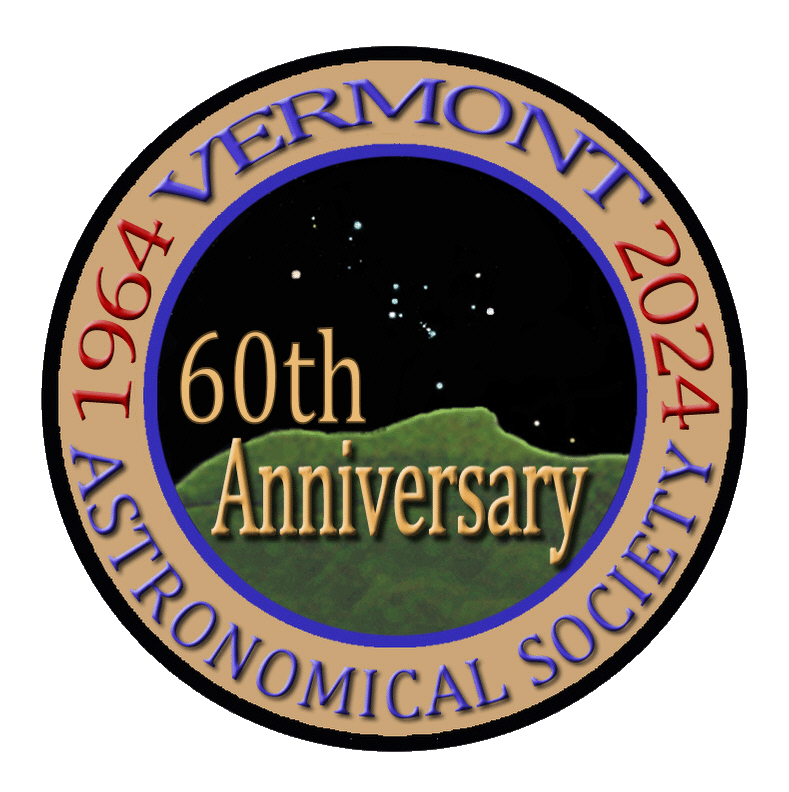- August 2, 2024
-
-
Stellafane
August 2, 2024 - August 3, 2024
Stellafane East, Jordan Rd, Springfield, VT 05156, USANote- Normal days are Friday - Sunday morning. Thursday is only if you register for early entry.
For details and registration go to Stellafane.org
-
- August 3, 2024
-
-
Stellafane
August 2, 2024 - August 3, 2024
Stellafane East, Jordan Rd, Springfield, VT 05156, USANote- Normal days are Friday - Sunday morning. Thursday is only if you register for early entry.
For details and registration go to Stellafane.org
-
- August 5, 2024
-
-
VAS Monthly Meeting
August 5, 2024 7:30 pm - 9:00 pm
Free and Open to the Public
In-person and via Zoom
Ask for the Zoom link via info@vtastro.org
VAS Members will be emailed the Zoom link
The in-person will be at the Brownell Library on 2A near 5-Corners in Essex Junction.
The library encourages masks, but does not require them. That policy may change over time, so watch for announcements.
The intention is to also stream the main speaker and presentation via Zoom for those who choose to attend remotely. If you don't have Zoom installed, the application will automatically download and install when you click the link. Or go to Zoom.us to download the interface application.Note:
The meeting starts at 7:30 pm, but you can join starting at about 7:15 or 7:20 PM to give you time to connect and work out any issues.PRESENTATION:
2024 Solar Eclipse Wrap Up
(2 of 2)
The 2024 Solar eclipse was a great success here in Vermont. The high thin clouds we had did little to dampen the show or our experience of it. Considering the number of people who witnessed and imaged the event we are splitting this between 2 consecutive meetings.Members will share their stories as well as some of their images of the event. Some members observed interesting behavior of animals as the sky darkened. An unexpected and not so pleasant consequence experienced by members in several places involved mosquitos! You may hear about several of these experiences.
Following the main presentation, our recurring monthly presentations will include Constellation of the Month by Terri Zittritsch
-
- September 6, 2024
-
-
Observing at the Hinesburg Site
September 6, 2024 7:15 pm - 11:30 pm
Thin crescent Moon with Earthshine and Deep Sky. Gate opens 7:15 PM. If you get there early enough (before ~7:30 ) you may catch a glimpse of Venus before it sets at ~7:40 PM. Deep Sky observing starts about 8:45 PM Sunset 7:16 PM. Full darkness 9:00 PM.
Contact Paul Walker via: info@vtastro.org
-
- September 7, 2024
-
-
Rain Date-Observing at the Hinesburg Site
September 7, 2024 7:15 pm - 11:30 pm
Rain Date Only
Thin crescent Moon with Earthshine and Deep Sky. Gate opens 7:15 PM. If you get there early enough (before ~7:30 ) you may catch a glimpse of Venus before it sets at ~7:40 PM. Deep Sky observing starts about 8:45 PM Sunset 7:16 PM. Full darkness 9:00 PM.Contact Paul Walker via: info@vtastro.org
-
- September 9, 2024
-
-
VAS Monthly Meeting
September 9, 2024 7:30 pm - 9:00 pm
Free and Open to the Public
In-person and via Zoom
Ask for the Zoom link via info@vtastro.org
VAS Members will be emailed the Zoom link
The in-person will be at the Brownell Library on 2A near 5-Corners in Essex Junction.
The intention is to also stream the main speaker and presentation via Zoom for those who choose to attend remotely. If you don't have Zoom installed, the application will automatically download and install when you click the link. Or go to Zoom.us to download the interface application.Note:
The meeting starts at 7:30 pm, but you can join starting at about 7:15 or 7:20 PM to give you time to connect and work out any issues.PRESENTATION:
Seestar S50 - Toy, Beginner Telescope or Outreach Tool
By Dave LegrowThis presentation is about what you can expect from the Seestar. It is a small automatic, imaging only, telescope that one operates via a smartphone or iPad.
Dave will cover the specifications, translating them into realistic expectations. He will include some sample photos he has taken. Ease of use will be covered and hopefully include a live demonstration (may need a volunteer from the audience). This telescope is useful for outreach events. Dave will talk about what accessories are available and which ones are worthwhile.
Following the main presentation, our recurring monthly presentations will include Constellation of the Month by Terri Zittritsch
-
- September 27, 2024
-
-
Observing at the Hinesburg Site
September 27, 2024 7:15 pm - 11:30 pm
Gate opens 7:15 PM. Observing starts about 8:45 PM Sunset 6:35 PM. Full darkness 8:15 PM.
Contact Paul Walker via: info@vtastro.org
-
- September 28, 2024
-
-
Rain Date-Observing at the Hinesburg Site
September 28, 2024 7:15 pm - 11:30 pm
Rain Date Only
Deep Sky Gate opens 7:15 PM. Observing starts about 8:45 PM Sunset 6:35 PM. Full darkness 8:15 PM.Contact Paul Walker via: info@vtastro.org
-
- October 4, 2024
-
-
Observing at the Hinesburg Site
October 4, 2024 7:15 pm - 11:30 pm
Gate opens 7:15 PM. Observing starts about 8:00 PM Sunset 6:25 PM. Full darkness 8:15 PM.
Contact Paul Walker via: info@vtastro.org
-
- October 5, 2024
-
-
Rain Date-Observing at the Hinesburg Site
October 5, 2024 7:15 pm - 11:30 pm
Rain Date Only
Gate opens 7:15 PM. Observing starts about 8:00 PM Sunset 6:25 PM. Full darkness 8:15 PM.Contact Paul Walker via: info@vtastro.org
-
